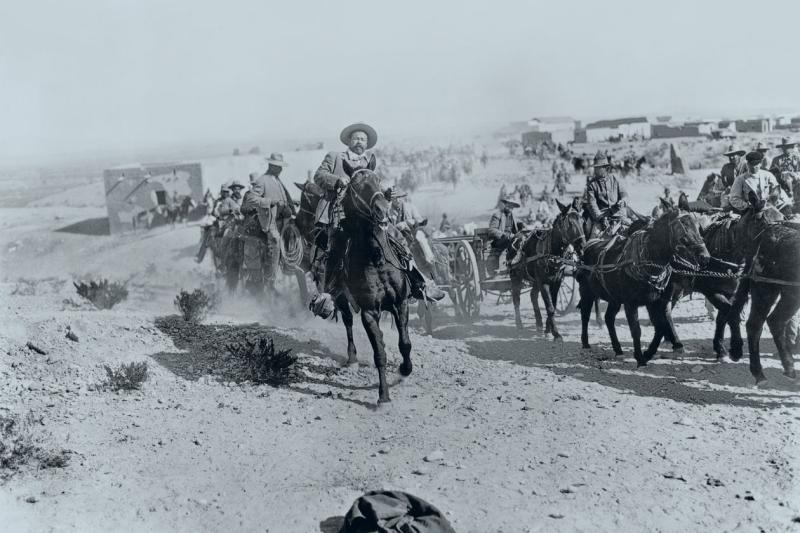'War on the Border' Review: The Pursuit of Pancho Villa
By: Peter Cozzens (WSJ)



On March 9, 1916, Doroteo Arango, known to history as Francisco "Pancho" Villa, attacked the ramshackle border town of Columbus, N.M., to provoke an American invasion of Mexico that he believed would restore his flagging fortunes as a Mexican revolutionary. President Woodrow Wilson obliged him. He authorized Brig. Gen. John J. "Black Jack" Pershing to conduct an expedition into Chihuahua, Mexico, to slay or seize Villa and destroy his rebel force. During the ensuing 11 months of hot, dusty marches, Pershing failed to kill, capture or even spot Pancho Villa. The U.S. Army, however, fought several desultory skirmishes with Villa's men and learned valuable lessons in organization, tactics and logistics that would prove highly useful when it entered World War I the following year. The "Punitive Expedition" also failed to revive Villa's reputation, and he spun slowly into irrelevance amid the swirling waters of Revolutionary Mexico.
Celebrated Texas author Jeff Guinn's "War on the Border" aims to tell the story of this important episode in Mexican-American relations. The book doesn't fully deliver on its ostensible purpose, however. Although engagingly written, it is a largely unoriginal, thinly researched work that, judging by the author's notes, relies heavily on secondary sources and on interviews with modern historians. The result is a story that concentrates as much on the endless intriguing among the parade of Mexican strongmen and idealists who wrestled for control of Revolutionary Mexico, and on nearly a century of American-Mexican relations prior to 1916, as it does on the professed topic of the book.
Examples of the derivative nature of "War on the Border" are many. As Mr. Guinn acknowledges, entire chapters are based in large measure on interviews he conducted with authors of books on the subject. A perusal of the bibliography reveals that Mr. Guinn used few Mexican sources and made no use of contemporaneous Mexican newspapers, which are readily available online and offer that nation's perspective on Villa's raid and Pershing's expedition. Neither did Mr. Guinn consult "Ocho Mil Kilometros en Campana" ("Eight Thousand Kilometers on Campaign"); the military memoirs of Gen. Alvaro Obregon, a towering Mexican figure of this epoch; nor the essential John Pershing Papers and Hugh Lenox Scott Papers in the Library of Congress. Mr. Guinn also neglected the vast resources of the National Archives, which include not only invaluable Army correspondence but also affidavits and eyewitness accounts by residents of Columbus. He also omits accounts by U.S. soldiers, rendering his tale decidedly sterile. The actions of the black Buffalo Soldiers of the 10th U.S. Cavalry are addressed only in passing, and no mention is made of the Apache scouts who served Pershing on the expedition. The book thus lacks any real appreciation of race relations in the U.S. Army at the time.
Besides calling into question the need for a new book on the Punitive Expedition, an overreliance on secondary sources and their authors perpetuates incorrect facts and interpretations. I was surprised to read, for instance, that "American newspaper and magazine correspondents, including John Reed and Ambrose Bierce, were welcomed to accompany Villistas, chronicling their gallant efforts for enthralled American readers." In fact, there is no evidence that Bierce, who disappeared in 1913, ever entered Mexico. The views of other historians seem at times to substitute for the author's own analysis or conclusions. Writing of racial antipathy in Texas, Mr. Guinn says:
The suspicion was mutual. Historian Arnoldo de León explains, “Those Tejanos [Mexican residents of Texas] who tried to remain where they were in what was now America faced all kinds of racism, segregation, and even lynchings. These things confirmed the suspicions that they’d had. Mexican children, Tejano kids, were taught by their parents and grandparents not to trust white people because they were always out to harm us. It was a form of self-protection to always be distrustful.”
“War on the Border” also suffers from an absence of adequate maps. There are only three: one of the U.S. land acquisitions from Mexico in the 1840s, another a sparse view of the U.S.-Mexico border and a third that sketches the route of the Punitive Expedition. As a consequence, it is difficult to follow the action, particularly as some of the events described, such as the American occupation of Veracruz, occurred outside the limited scope of the maps. There is no map of the border town of Columbus as it existed at the time of Villa’s raid in March 1916, nor of the locations of any of the numerous clashes between Villistas and Pershing’s forces during the course of the Punitive Expedition. Fortunately, readers of “War on the Border” can find such maps in Julie Irene Prieto’s “The Mexican Expedition, 1916-1917,” a fine publication that may be downloaded free of charge from the U.S. Army Center of Military History.
I found Mr. Guinn’s subtitle—“Villa, Pershing, the Texas Rangers, and an American Invasion”—misleading. “War on the Border” is far more a work about Pancho Villa’s controversial role in the Mexican Revolution than it is about either Pershing or the Texas Rangers, who played only a peripheral role in the proceedings. From the outset, Villa dominates much of the narrative; Pershing isn’t introduced to readers until halfway through the book. The Texas Rangers, who didn’t participate in the Punitive Expedition, are accorded two chapters devoted to their role in the “Bandit War,” a series of raids into Texas between 1915 and 1919 by Mexican rebels who were abetted by Mexican-American sympathizers, a motley crew collectively known as the Seditionistas (seditionists). Villa played no role in this conflict.
Mr. Guinn’s deft writing makes “War on the Border” an enjoyable primer on Mexican-American relations in the latter years of the 19th-century and during the Mexican Revolution, as well as an adequate introduction to Mexican political intrigues of the time. Those seeking a deeper understanding of the era in general, and of the Punitive Expedition in particular, would benefit from three outstanding works that underpin much of “War on the Border”: Friedrich Katz’s “The Life and Times of Pancho Villa”; Eileen Welsome’s “The General & the Jaguar: Pershing’s Hunt for Pancho Villa”; and John S.D. Eisenhower’s “Intervention! The United States and the Mexican Revolution, 1913-1917.”
—Mr. Cozzens’s latest book is “Tecumseh and the Prophet: The Shawnee Brothers Who Defied a Nation.”





Sounds like a fascinating story. Do our children know? Do they teach anything in a US history class other than "slavery?"
The Book is
WAR ON THE BORDER
By Jeff Guinn
Simon & Schuster, 350 pages
(Not to be confused with the crisis on the border)
Pancho chased political windmills ... you seem to be doing the same.
Here are some other things that can be taught the we seem to avoid.
Forgotten Dead: Mob Violence Against Mexicans in the United States
Colonial Enslavement of Native Americans Including Those Who Surrendered (Oh my, more slavery)
Two Faces of Exclusion: The Untold Story of Anti-Asian Racism in the United States.
And the murder of whites.
Some people are obsessed with portraying whites as the victim. If it wasnt so sad it would be funny.
[DELETED]
Ten miles from where you live!